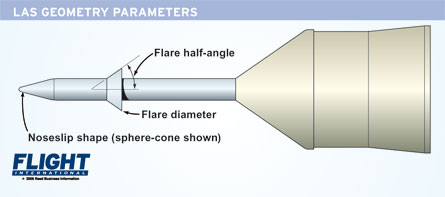The discovery of drag-inducing shockwaves during windtunnel testing of NASA's Ares I crew launch vehicle has led to a redesign of the flared section between the launch abort system (LAS) tower and the Orion crew exploration vehicle.
The flare covers the nozzles of the LAS's solid rocket motors, which would ignite to pull the crew capsule clear of the launch vehicle in the event of an emergency. The shockwaves were first observed during testing of an Ares I Design and Analysis Cycle 1 (DAC-1) model in Boeing's polysonic windtunnel at simulated speeds of Mach 1.45 and above. The 1%-scale, 965mm (38in)-long full protuberance model of the Ares/Orion/LAS stack was tested at speeds from M0.5 to M1.6.
"The Orion and LAS project teams needed to understand the aerodynamic phenomena occurring near the front end of the Ares I/Orion/LAS stack," says a N ASA paper submitted to the 2006 International Astronautical Congress held last month in Valencia, Spain. The shockwaves appeared as the launch vehicle's pitch changed and remained even after pitching the model back again.
The anomaly was confirmed in a NASA Langley windtunnel and further evidence was obtained in the trisonic tunnel at NASA Marshall's aerodynamic research facility.
The anomalous shockwave findings contrasted to Ares I DAC-0 studies that found the LAS could offer improved aerodynamic performance, acting like a drag-reducing aerospike.
A subsequent DAC-1 LAS geometry trade study concluded that, for reduced drag, the LAS should have a wide-diameter tower and a wide flare extending well forward along its length. But the new findings have forced researchers to conclude this study may need re-examining.

Source: Flight International




















